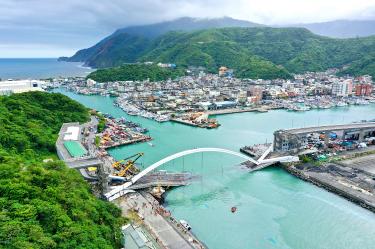Yesterday’s collapse of the Nanfangao Bridge (南方澳橋) in Yilan County might have been due to rusted anchoring points, Taipei Technology College of Engineering dean Sung Yu-chi (宋裕祺) said.
Video footage showed that the vertical cable at the center of the bridge’s steel arch was the first to snap, Sung said.
However, the bridge is suspended by 10 or more steel cables and theoretically, the other cables should have been capable of evenly distributing the weight the broken cable had borne, he said.
However, it looks like the snapping of the vertical cable caused a domino effect, Sung said.
The bridge was continuously exposed to salty air, which would have rusted the cables, reducing the amount of weight the span could support, Sung said.
Long-term exposure to wind could have also loosened the anchor points, making them unable to sustain the bridge’s weight, he said.
The collapse of the arch was caused by the dissolution of the force equilibrium between the bridge and the arch, although an investigation is needed to confirm the cause, he said.
Bridges are designed with safety factors and mechanisms taken into account, and routine inspections and precise equipment calibrations are required to maintain normal operations, he said.
Wang Chung-yu (王仲宇), a professor of civil engineering at National Central University, also said the cables could have rusted.
Strong winds brought by Typhoon Mitag would have caused the cables to sway constantly, which could have forced the cables to the point of snapping, Wang said.
An site inspection to determine which anchor point broke first is required, he said.
Authorities should make precise records of the site to compare with the records of the bridge’s last inspection, which could help clarify what happened, Wang said.
The bridge was an older design, created when the idea of protection from natural erosion was not yet popular, and it was possible that maintenance checks could have overlooked such possibilities, he added.
However, he believes that Mitag should be blamed for the collapse.
Taiwan International Ports Corp (TIPC) said it has conducted routine annual maintenance since the bridge was completed 21 years ago and, per regulations, each cable cord was inspected every four years.
The last inspection was conducted in 2016, when the Yilan County Government awarded the commission to Chien Hsin University of Technology and Science, TIPC said.
The university’s report suggested reinforcing the bridge body with concrete, removing rust from the cable beams, repairing the downspouts and replacing the expansion joints of the angle iron, it said.
It budgeted NT$10 million (US$322,113 at the current exchange rate) between 2017 and last year to cover the repairs and reinforcements noted in the report, the company said.
TIPC chief executive Chen Shao-liang (陳邵良) declined to comment on whether the cables snapped first, saying only that the company would await the results of the investigations.
Additional reporting by Hsiao Yu-hsin
Source: Taipei Times - 2019/10/02





















